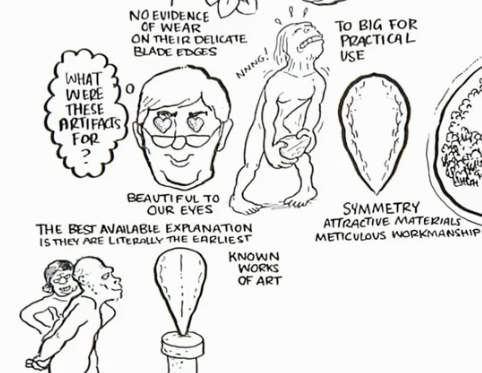But, someone might argue, that's natural beauty.
但有人也许会争辩,那是自然美。
How about artistic beauty? Isn't that exhaustively cultural?
艺术的美又如何呢?那难道不是纯粹的文化影响吗?
No, I don't think it is. And once again, I'd like to look back to prehistory to say something about it.
不,我不这么认为。再次,我们回到史前,聊聊史前的一些事。
It is widely assumed that the earliest human artworks are the stupendously skillful cave paintings that we all know from Lascaux and Chauvet.
普遍认为,最早的人类艺术品是极富技巧的洞穴画,我们都知道从拉斯科洞窟到萧韦洞窟。
Chauvet caves are about 32,000 years old, along with a few small, realistic sculptures of women and animals from the same period.
萧韦洞窟大约有3万2千年的历史,其中还有同一时期的一些小的、写实的妇女和动物的雕像。
But artistic and decorative skills are actually much older than that.
但艺术和装饰技巧的存在实际上要更早些。
Beautiful shell necklaces that look like something you'd see at an arts and crafts fair,
漂亮的贝壳项链,看起来就像是艺术品和手工艺品,
as well as ochre body paint, have been found from around 100,000 years ago.
还有赭色的人体绘画,远在10万年前就存在了。

But the most intriguing prehistoric artifacts are older even than this.
但最酷的史前人工制品比这些还要早。
I have in mind the so-called Acheulian hand axes.
我印象中是被称为阿舍利手斧的手工制品。
The oldest stone tools are choppers from the Olduvai Gorge in East Africa.
最古老的石制工具是在东非的奥杜威峡谷发现的石斧。
They go back about two-and-a-half-million years.
它的历史要追溯到两百五十万年前。
These crude tools were around for thousands of centuries,
这类粗糙的工具存在了数千个世纪,
until around 1.4 million years ago when Homo erectus started shaping single, thin stone blades,
直到大约一百四十万年前,直立人开始打磨单个的薄石刀片,
sometimes rounded ovals, but often in what are to our eyes an arresting, symmetrical pointed leaf or teardrop form.
有时是椭圆形的,但通常,在我们眼中,是醒目的对称的尖叶子形或泪滴形。
These Acheulian hand axes -- they're named after St. Acheul in France, where finds were made in 19th century
这些阿舍利手斧--名称取自法国的圣阿舍尔,这些手斧是十九世纪在那儿发现的
have been unearthed in their thousands, scattered across Asia, Europe and Africa,
出土了数千件,散布在亚洲、欧洲和非洲,
almost everywhere Homo erectus and Homo ergaster roamed.
几乎遍布每一处直立人或者匠人到过的地方。
Now, the sheer numbers of these hand axes shows that they can't have been made for butchering animals.
这些手斧众多的数量表明它们不是用于屠宰动物。
And the plot really thickens when you realize that, unlike other pleistocene tools,
更复杂的是当你考虑到,不像其他更新世的工具,
the hand axes often exhibit no evidence of wear on their delicate blade edges.
在这些手斧精美脆弱的刀刃边缘找不到任何磨损的痕迹。
And some, in any event, are too big to use for butchery.
而且它们中的一些,无论用在屠宰什么动物上,都太大了点。
Their symmetry, their attractive materials and, above all,
它们的对称性和引人注意的材料,还有,尤其是,
their meticulous workmanship are simply quite beautiful to our eyes, even today.
它们那精细的做工对我们来说非常美丽,即使在今天也是如此。











